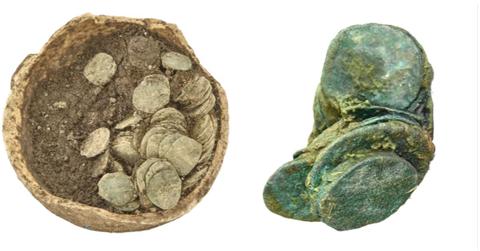Buried Bounty: Real Estate Dig Unearths Hidden Caches Containing 2,000 Medieval Coins

Archaeologists in France uncovered medieval coins while preparing a piece of land for construction.
During preparations for a construction project in France, archaeologists made a significant discovery: over 2,000 medieval coins spread across four hidden caches.
The coins, dating back nearly 850 years, were unearthed between 2021 and 2022 during excavations preceding a real estate development in Guérande, a town in Western France, according to the Institut National de Recherches Archéologiques Préventives (INRAP).
This revelation sheds light on a time when the bulk deposition of currencies was uncommon, according to experts.
One cache, the oldest, was discovered as an "isolated deposit" nestled inside an oak container near the town center, dating back to the 12th to 13th centuries. The other three caches were found in a corner of a 14th-century masonry building, stored in ceramic pottery, some of which showed signs of wear and tear.
Another cache was found in a "remarkable" state of preservation, enclosed in a leather envelope and wrapped in linen fabric, INRAP stated.
The rarity of finding ancient currencies stored in such a manner piqued the researchers' interest, prompting further investigation into medieval hoarding and money management practices.
Never miss a story — sign up for the Front Page Detectives newsletter. Be on the scene the moment news breaks.
Following careful sampling, the deposits were sent to a research center for analysis by specialists aiming to unravel the intricacies of medieval domestic finances.
Prior to manual excavation, non-destructive imaging techniques were employed to create 3D models of the artifacts, enabling analysis while preserving the fragile contents.
The discovery offers a glimpse into the historical significance of Guérande, which traces its roots back to the ninth century, with the construction of its town wall occurring between the 13th and 15th centuries.
Become a Front Page Detective
Sign up to receive breaking
Front Page Detectives
news and exclusive investigations.
